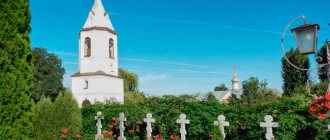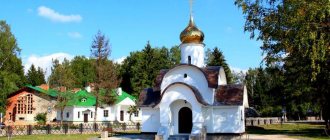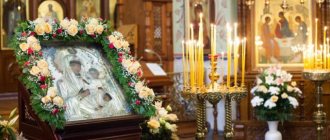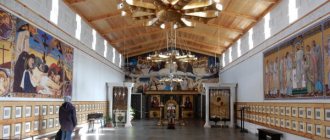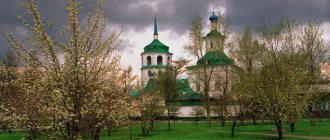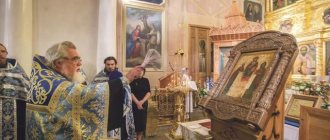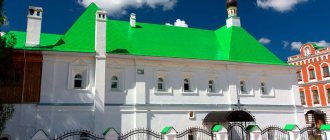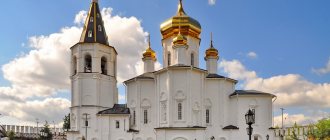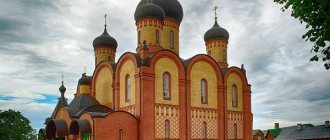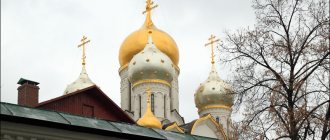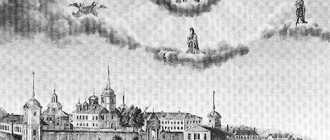Russia is full of beautiful and majestic churches, but few of them compare with the Kazan Convent, which is one of the oldest in the Russian Federation. It is also known by the name Yavlensky, because it was here that the miraculous icon of the Mother of God of Kazan appeared to people.
Despite many years of desolation and devastation, the monastery today is slowly being restored and is reviving its educational and spiritual value for Ryazan. The extraordinary Kazan Church rises above the city and attracts the attention of all passersby.
History of the monastery
According to documentary evidence, the monastery in honor of the image of the “Kazan” Mother of God was founded in the 16th century and was originally located next to the Spassky Monastery. The original wooden church was located on its territory. The large stone church was erected in the 17th century with the participation of Metropolitan Abraham. The monastery was supported by state benefits in the form of money and bread until 1764, and in 1779 a decision was made to move it to its modern location.
Kazan Convent of the city of Ryazan
Through the efforts of the abbess, the monastery flourished and grew. In 1861, with the support of unknown benefactors, a hospital was opened here for sick nuns and anyone in need of help. In 1863, the monastery came under the control of Abbess Eugenia, who was able to do an incredible amount:
- A 4th grade school for girls was opened.
- A new Kazan temple with chapels was built (with the martyr Harlampy and St. Sergius of Radonezh).
- The gate church of St. Barbara was built.
Throughout the history of the monastery, it has kept amazing icons, and some of them were painted by Mr. Zhivago. In addition to icons, many gold and silver utensils, sacred vessels, crosses and arks were kept in the churches. The monastery had many patrons and they all donated generously. In total, there were 40 buildings on the territory and among them:
- wooden house of the abbess;
- 6 stone buildings for nuns;
- hospital and pharmacy premises;
- school;
- library-reading room;
- candle production building;
- bakery;
- outbuildings.
The entire territory was surrounded by a stone fence and had two pairs of gates - eastern (with the Church of St. Barbara) and western. Pilgrims could stay outside the monastery, in a special hotel building. The nuns, in addition to working on the grounds, teaching and making candles, cultivated a 2.5-hectare vegetable garden.
Kazan Yavlensky (Maiden) Convent at the beginning of the 20th century
With the beginning of the revolution, all the nuns were expelled, and all property was requisitioned by the Soviet authorities. The high stone fence was useful to the Bolsheviks to keep everyone dissatisfied with their leadership - the city government and the gendarmes were waiting for their verdict here. After the end of the Civil War, a club was set up here for soldiers of the Red Army; all the paintings and icons were painted over. In addition to the club, during Soviet times a colony for street children and a sewing workshop were set up here. The Church of Barbara was given over to a residential building, and the bell tower on it was demolished. Other buildings were used for offices, the necropolis was completely looted and destroyed.
Only in 2006, the Kazan Convent again became part of the Russian Orthodox Church and began restoration. Today only the Kazan Church has survived, and the Church of St. Barbara remains a residential building. In 2007, the altar in the Kazan Church was consecrated and the first liturgy was held for Christmas.
Dmitriev Ryazhsky Monastery[edit]
A monastery, according to legend, founded in memory of the Battle of Kulikovo. It has been documented since 1631. The brick buildings were built in the 18th-19th centuries, the separate gate bell tower is from the 1st floor. XIX century In the 19th century not crowded, closed no later than the 1920s, the buildings were used for economic purposes, abandoned by the 1970s, partially ruined. Object of cultural heritage of the Russian Federation. Founded no later than the 16th century. Active. Restored in 1995, buildings renovated.
Address:
391842, Ryazan region, Skopinsky district, Zarechny settlement, c. Dmitrievo.
Telephone:
+7 910 643 24 02
Directions:
by regular bus or minibus from the Central bus station in Ryazan to the bus station in Skopin, from Skopin by minibus No. 133 to Zarechny. Stop before entering the village. Further left along the road on foot 3 km to the village of Dmitrovo.
Description of the architecture
Initially, the Kazan Convent occupied an entire block along Furmanov Street and included more than 40 different buildings, including two churches. Today the monastery is just in the process of being revived after the devastating years of neglect during the USSR. Restoration will not only help restore destroyed buildings, but also return them to as close to their original appearance as possible.
The Kazan temple was laid out of stone using solid masonry technology, without gaps. Its walls were covered with a thick layer of lime inside and out, and the roof was covered with thick sheets of black iron. The roof was also painted with special oil-based white paint. On the domes there were slotted crosses, which were covered with gold leaf. Their base was strengthened in the same gilded apple-heads. On the southern and northern sides of the building there were oblong windows, semicircular at the top. They were decorated with artistic forged steel designs.
The refectory and altar hall were made to look like marble - their floors were lined with yellow marble slabs. The vaults were made in the form of domes and chandeliers were lowered from their centers downwards on chains. The walls and vaults themselves were decorated with paintings of holy scenes, but their author is unknown. In terms of the style of writing (a subtle combination of church canons and artistic painting), the paintings resemble the work of the master of painting Shumov, who lived in Ryazan in 1857 - 1904.
Interior decoration of the Kazan Church
Above the altar vault were three huge iconostases covered with gilding and rich decorations. The main one had three tiers and it was in it that the miraculous icon of the Mother of God “Kazan” was installed. The Kazan temple was heated with an oven and therefore services were held there all year round.
The second church of the monastery was the gate church and was located above the western gate. It was consecrated in honor of the Great Martyr Barbara in 1870. It was in it that there was an entrance to the nunnery. The temple had a special architecture - it was combined with a tier of a bell tower, which was square in shape. It was crowned by a head together with a large cross, and the bell tower had 1 bells. This church was unheated and services were held here only in the warm season.
After the looting, the temple was given over by the Soviet authorities as a simple residential building, and it remains that way to this day.
Mother of God of Mercy Kadoma Convent[edit]
The Mother of God of Mercy Kadoma Convent is an Orthodox convent founded in 1797. After 1917, the monastery was purposefully destroyed. Revived in 1997. There is a refectory and a hotel at the monastery.
Telephone:
+7(49139)5-13-49
Address:
Russia, Ryazan region, town Kadom, lane. Oktyabrsky, building 1
From Moscow you can get to Kadom by direct bus from the Shchelkovo bus station, the travel time is about 9 hours. By train - to Sasovo station, then by bus, the distance is about 60 kilometers. By train - "Moscow - Ryazan" (3 hours) and "Ryazan - Sasovo" (3 hours). By car - along the federal highway M-5 (Ural) to Shatsk, where you should turn left and go through Sasovo to Kadom (you can also choose the route through Yegoryevsk, Spas-Klepiki, Kasimov).
Monastery in Kadoma on the main and only square.
From the Mervinsky bus station in Ryazan by regular bus or minibus to the Kadom r/p
Activities of the parish
Today the monastery is under the control of Abbess Anna (Sychugova). Divine services are held here daily according to the established schedule:
- morning service at 7 am on weekdays, and at 8 am on holidays;
- Vespers at 5 pm;
- lithium for the deceased daily at 6.40 am;
- on Sunday holidays there is also a water prayer service at 9 am.
On a note!
In addition to divine services, since 2007, the Ryazan Women's Diocesan Theological School has also been operating on the territory of the monastery. It became a continuation and transformation of the previously existing school of regents-psalmists. Today, any girl can enter the school if she wishes and upon graduation receive an appropriate diploma. The monastery publishes the periodical “Bulletin of the Kazan Monastery” and operates a Sunday school for adults and children.
Preobrazhensky Ryazan Monastery[edit]
The history of the monastery is connected with the history of the city, which was founded by Bishop Arseny of Murom and Ryazan. Ancient chronicles speak of the monastery as Preobrazhensky, “which is inside the city.” During the Mongol-Tatar invasion, Pereslavl-Ryazan received refugees from the devastated Old Ryazan, and in 1288 Saint Basil of Ryazan moved his see here.
There is a legend that the monastery was founded at the same time - at the end of the 13th or at the beginning of the 14th century. Most likely the monastery was founded under Grand Duke Oleg Ivanovich. The Grand Duke of Ryazan Ivan Vasilyevich took care of the organization of the monastery, who in 1467 granted it lands with his charter.
In 1501, according to a new charter from Prince Fyodor Vasilyevich, the village of Gavrilovskoye was donated to the monastery.
Address:
st. Kremlin, 1, Ryazan, Russia, 390000
Telephone:
+7 491 228-08-03
Shrines and patronal feasts
Pilgrims can come to the monastery on any day, but it is especially recommended to visit the holy places on the days of the Mother See holidays:
- the appearance of the image of the “Kazan Mother of God” - July 21 and November 4;
- VLM Remembrance Day Varvara - December 21;
- SVMC Memorial Day Harlampy - February 23;
- finding the relics of St. Sergius of Radonezh - July 18.
Divine service at the Kazan Convent
But even on weekdays, non-holiday days, you can bow and look at the shrines of the Kazan Monastery:
- miraculous icon of Our Lady of Kazan;
- icon of Saints Peter and Fevronia;
- image of the Virgin Mary “Quick to Hear”;
- arks with the relics of saints Simon the Canaanite and Anna Sreznevskaya.
Holy Spirit Skopinsky Monastery[edit]
Date of foundation
: no later than the beginning XVII century
Address
: Ryazan region, Skopin, Trinity Grove
Web
: https://svdskopin.ru/
Monastery, known since the end. 1620s as Trinity. It was located in a grove southeast of the city. It was not rich, but was abolished in 1764. In 1786, the brethren of the Ryazan Spiritual Monastery were transferred to its buildings, and therefore it was restored and named the Holy Spiritual Monastery. In the 19th century not crowded, the gate bell tower was built in the beginning. XIX century Closed shortly after the revolution, some of the buildings were broken down and were used as an orphanage and later a boarding school. In 2013, some of the buildings were returned to believers and have the status of a bishop's metochion.
Notes
: There is a legend about the founding of the monastery in the end. 1380s in memory of the reconciliation of Dmitry Donskoy with the Ryazan principality.
Holy Transfiguration Pronsky Monastery[edit]
The history of the Pronsk Spasskaya Hermitage, now called the Spaso-Preobrazhensky Pronsky Monastery, has its roots in the early seventeenth century.
It is not known for certain who was the founder of the Pronskaya Spasskaya Hermitage and when it was founded. This is exactly what is stated in the second volume of priest Ioann Dobrolyubov, “Historical and statistical description of churches and monasteries of the Ryazan diocese, currently existing and abolished, with lists of their abbots for the 17th, 18th and 19th centuries and bibliographic instructions”: “The time of its foundation is not known, but its existence its existence in the 17th century is beyond doubt.” In the Pestsov books of 1640, Prince Borzetsov indicated that in the calculation of various lands belonging to the archers of the old settlement, it was said, among other things, that they had a pasture opposite the “Spassky Monastery” in common with the new archers. The mid-17th century in Russia was marked by church reform, which had far-reaching consequences both for the Church and for the entire Russian state. It is known for certain that in 1665 the rector of the Spasskaya Hermitage was the Black novice Paphnutius.
Address:
391140, Russian Federation, Ryazan region, r.p. Pronsk, st. Novo-Streletskaya, 9
Telephone:
+7 (920) 966 77 21
Nikolo-Cherneevsky Monastery[edit]
The St. Nicholas Cherneevsky Monastery was founded in 1573 by a Don Cossack named Matthew, who arrived from the Don to the Tsna River, within the boundaries of the present Shatsky district, Ryazan region. In imitation of the ancient hermits, looking for solitude for spiritual exploits, he settled in an impenetrable forest, near the villages of Mordva. The paganism of the Mordvichs saddened the pious elder and he decided to proclaim to them the Faith of Christ. Intelligent conversation in their native language, which he learned on purpose for this purpose, and his strict, ascetic life attracted everyone’s attention to him. Every day the increasing number of his disciples prompted the elder to ask for the blessing of the Ryazan Bishop Leonid to found a monastery in the forest he inhabited. In 1573, Bishop Leonid Matthew was ordained a hieromonk and appointed builder of a newly established monastery, now located on the Tsna River, 20 kilometers from the city of Shatsk, Ryazan region. The monastery was founded in the name of St. Nicholas the Wonderworker and was named Cherneev, from “the dense black forest that surrounded it.” In ancient acts it was also called the Matthew Desert.
Address:
391588, Ryazan region, Shatsky district, village. Starocherneevo.
Solotchinsky Nativity of the Virgin Mary Convent[edit]
The Ryazan monastery began with the monks Vasily and Euthymius. I met them in 1390 on the banks of the river. Solotchi, Prince Oleg Ryazansky, founded a monastery in the same year and took monastic vows here himself. He took care of the monastery and lived in it for a long time, carrying out obedience. His wife founded the Conception Convent nearby and took monastic vows in the name of Eupraxia. Oleg died in 1402, having adopted the schema with the name Joachim before his death. His ex-wife died three years later. Both were buried in the Solotchinsky Monastery.
The monastery operated until the 1920s. as masculine, but now it is feminine. The monastery has two functioning churches of the 17th century: the Descent of the Holy Spirit on the Apostles - winter and the Nativity of the Blessed Virgin Mary - summer.
The main shrine of the Ryazan monastery is the relics of the blessed prince Oleg of Ryazan, which rest in the Holy Spirit Church. The saint's memory is June 5 (18).
The village of Solotcha is located 20 km from Ryazan, on the banks of the Oka. These places are distinguished by the purity and richness of nature.
There are about 30 sisters in the monastery, but almost all are elderly. Working women are not accepted.
Directions From the Prioksky bus station there are flights every 2 hours.
Address:
391020, Ryazan region, Solotcha settlement. Tel.: (4912) 28-79-37.
Nikolo-Bavykinsky Monastery[edit]
Bell tower of the Nikolo-Bavykinsky monastery.
A majestic forest on the sandy Bavykina Mountain, at its foot the quiet Para River flows, bending around the mirror ponds. Flowering meadows along with a modest river complement with their beauty the picture of mighty pines and shy birches. In 1879, a peasant woman from the village of Belorechye, Elena Nikolaevna Sazonova, decided to settle in this place with the intention of forming a women’s monastic community. To do this, she bought from local owner A.F. Khanykov land, built a two-story building for sisters and a house church in honor of the Tikhvin Icon of the Mother of God. But the community was unable to pay all the money under the contract on time and soon closed. The pious merchant Alexey Shulgin learned about this misfortune and, trusting in the intercession of Nicholas the Wonderworker, took upon himself all contractual responsibilities. Soon, by the decision of the Holy Synod in 1888, a new Nikolo-Bavykinsky women's community was approved. And a different life began, imbued with the monastic spirit. The first sisters lived very simply, having common housing and food. We worked together in obediences, prayed together in the warm Tikhvin church.
On May 22, 1894, the community was transformed into a monastery. With the support of Alexey Shulgin and other donors, the monastery acquired the appearance of a remarkable architectural ensemble.
Address:
391791 Ryazan region, Saraevsky district, Zarya Svobody village, no. 22
Phone number of the abbot of the monastery
(abbot Pavel (Udovenko)): 8-920-989-64-20
Alexander Nevsky Iberd Convent[edit]
Date of foundation
: 1907
Address
: Ryazan region, Korablinsky district, ur. Sofroniev Monastery (3 km NE of Iberdsky village)
The monastery was built as a monastery for women near the place of residence of Elder Sophrony (Lisin) at the expense of benefactors in memory of the salvation of the royal family in the disaster of October 17, 1888. It was opened in 1892 as a women's almshouse, from 1904 - a community, from 1907 - a monastery. In 1919 it was closed, the buildings were dismantled. The temple was restored at the end. 1990s, nowadays - a place of active pilgrimage.
